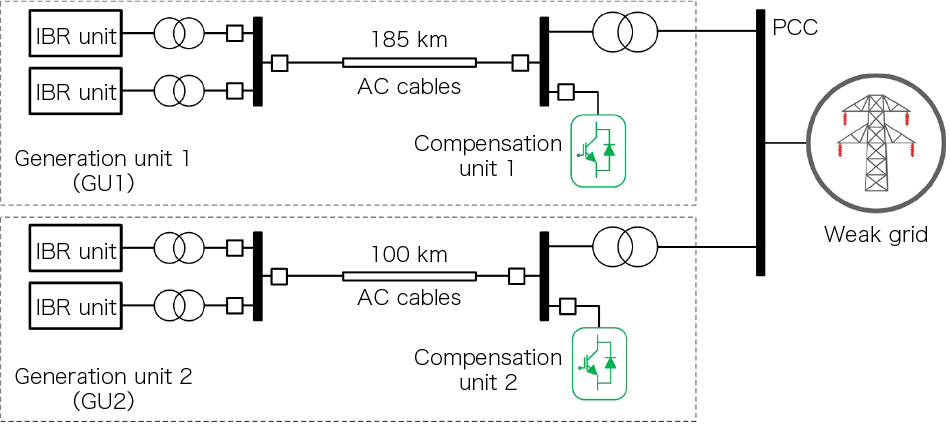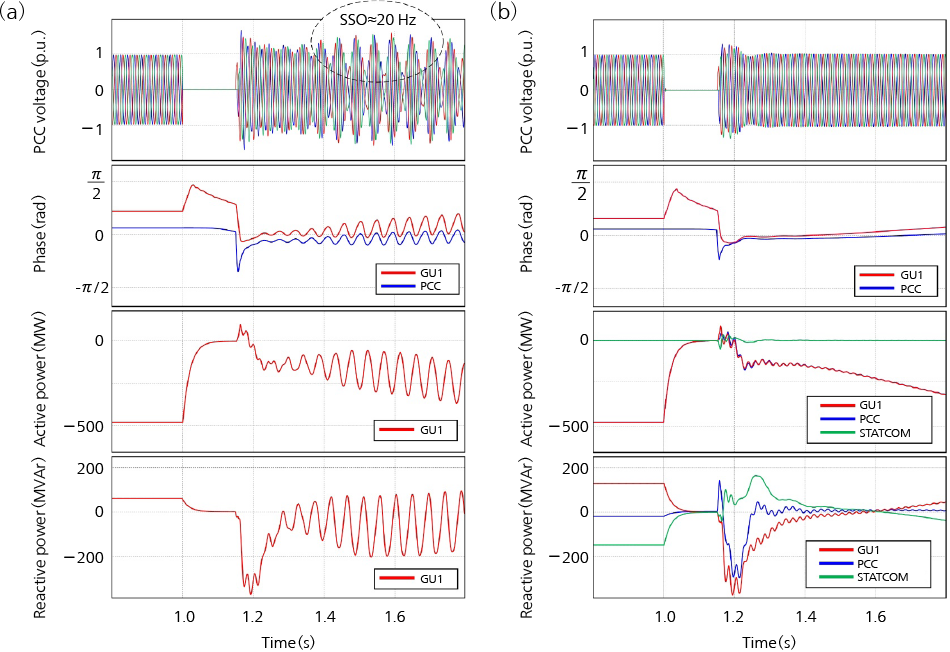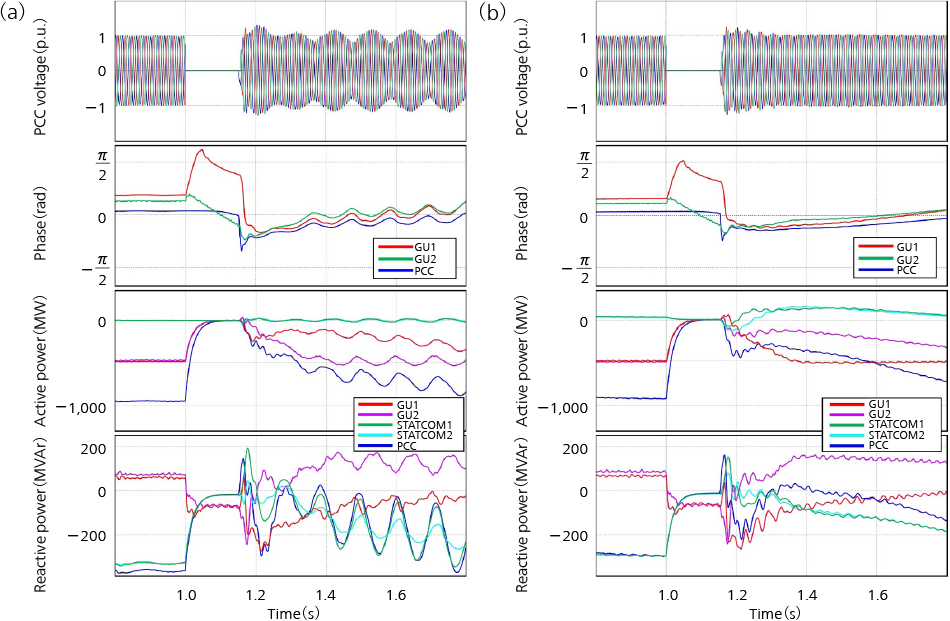Stability Enhancement of Weak Grids with High Penetration of Renewables with Grid Forming STATCOM/Enhanced-STATCOM
Highlight
Weak grids are characterized by low short-circuit power, sub-synchronous oscillations (SSO), and limited fault tolerance. They face challenges in maintaining stability under various operating conditions. The increasing integration of inverter-based resources (IBRs) and the growing demand for power further exacerbate these challenges. To address these issues, static synchronous compensators (STATCOMs) with grid-forming capabilities have been developed. GFM STATCOMs can improve grid stability and enhance grid strength by providing a simultaneous reaction to grid changes and proper damping. This article delves into the functionalities and design considerations of Grid-forming (GFM) STATCOMs and their enhanced counterparts, equipped with energy storage systems - the enhanced STATCOMs (E-STATCOM). Through simulation in the loop scenarios involving multiple IBRs connected to weak grids, the article demonstrates the effectiveness of GFM STATCOM and E-STATCOM in damping SSO, addressing phase angle instability, and providing grid voltage support. The findings highlight the potential of these technologies to actively shape and control grid conditions for enhancing grid stability.
1. Introduction
The traditional power system architecture, dominated by synchronous generators (SGs), is undergoing a transformation as more and more SGs are replaced by inverter-based resources (IBRs). This shift has led to a decrease in the number of SGs connected to the grid, posing stability challenges for grid operators. These challenges include an increased risk of sub-synchronous harmonic resonance, reduced system inertia, and a decline in the short-circuit ratio (SCR) of the grid, all of which can jeopardize the stability and availability of the power system.
To address these challenges, static synchronous compensators (STATCOMs) play a crucial role in supporting the grid voltage and enhancing the grid stability. Traditional STATCOMs operate with grid-following control (GFL), which adjusts the output of STATCOM to match the grid’s voltage and frequency. However, the conventional GFL approach encounters challenges in actively regulating and establishing independent control over grid voltage and frequency. These challenges spurred interest in developing more sophisticated control strategies.
One promising strategy is grid-forming control (GFM), which shifts the focus from basic reactive power support to actively shaping the grid voltage, and stabilizing weak grids with high penetration of IBRs. The adoption of GFM not only addresses the technical deficiencies associated with GFL, but also elevates the role of STATCOMs, with enhanced capabilities to contribute substantially to grid stability and reliability1-3). The GFM ability to actively control voltage and frequency enables STATCOMs to counteract the destabilizing effects of sub-synchronous resonances, ensuring a more robust and secure power system.
Combining STATCOM technology with energy storage systems, so-called enhanced STATCOM (E-STATCOM) creates a versatile solution for grid stability associated with weak grids. GFM E-STATCOM can contribute with both active and reactive power support which enables improved transient response during sudden changes in the grid frequency and voltage. The rapid response of energy storage, combined with the voltage and frequency control capabilities of E-STATCOM, enables quick and effective management of transient events, mitigates sub-synchronous oscillations (SSO), and ensures a reliable power supply in the face of dynamic conditions. This article is organized as follows: Section 2 addresses the challenges associated with weak grids and sub-synchronous oscillation. Section 3 explores the advancements in grid-forming STATCOM and enhanced STATCOM (E-STATCOM) technologies. Section 4 presents the results from simulation-in-the-loop studies, demonstrating the effectiveness of the proposed solutions. Finally, Section 5 provides the conclusion, summarizing the key findings.
2. Weak Grids and Sub-synchronous Oscillations
Weak grids pose unique challenges related to SSO requiring specialized design considerations for STATCOMs. Sub-synchronous torsional interactions (SSTI), or sub-synchronous control interactions (SSCI) amplified by compensated lines can lead to undamped oscillation modes, potentially resulting in catastrophic events4). To mitigate these challenges, extensive system studies are often conducted to demonstrate the STATCOMs do not contribute to oscillating modes. Renewable IBRs introduce additional complexities, because active power control and AC voltage control (AVC) loops may contribute to oscillating modes, especially when connected through long cable systems with significant capacitance. The 2019 UK blackout serves as an example, highlighting the importance of grid support for IBRs during grid disturbances4). Therefore, the design of E-STATCOMs for weak grids must address these challenges to ensure safe and stable operation.
3. Grid-forming STATCOM and E-STATCOM
The fundamental design consideration for shunt compensation revolves around ensuring that the converter connects to the grid without adversely affecting grid conditions during disturbances. This is crucial not only for the grid's health, but also to prevent overloading of the STATCOM equipment, eventually avoiding forced disconnection. It is also required that the STATCOM is able to operate and eventually support the grid during extremely low SCR, for example, during grid restoration. Consequently, incorporating energy storage capability, in addition to the energy stored within the converter valve, becomes essential for maintaining grid operation.
Figure 1 shows the general control structure of STATCOM consisting of current limiter control, measured voltage (Um) as well as AC voltage control, sub-synchronous damping control (SSDC), power control, internal voltage source (IVS), and a virtual impedance:
Zv = jXv + Rv (1)
Ideally, Zv defines the STATCOM impedance seen by the grid, and it is structured as a passive R-L circuit ensuring passive behavior. The virtual reactance Xv dictates “Grid Strength” support, voltage support, and frequency support capabilities, similar to a synchronous machine and its sub-transient reactance. The resistive part Rv contributes to transient damping, crucial for damping the DC component arising during grid fault conditions or geomagnetic storm events.
Figure 1—Grid-forming Control Structure SSDC: sub-synchronous damping control, IVS: internal voltage sourceThis diagram shows the general control structure of STATCOM, consisting of current limiter control, measured voltage (Um) as well as AC voltage control, sub-synchronous damping control (SSDC), power control, internal voltage source (IVS), and a virtual impedance.
SSDC: sub-synchronous damping control, IVS: internal voltage sourceThis diagram shows the general control structure of STATCOM, consisting of current limiter control, measured voltage (Um) as well as AC voltage control, sub-synchronous damping control (SSDC), power control, internal voltage source (IVS), and a virtual impedance.
4. Simulations in the Loop (SIL) Results
To assess the efficacy of the GFM STATCOM in the context of high penetration of renewable IBRs, simulations were conducted on a comprehensive test system. The system, depicted in Figure 2, comprises IBR units linked to a weak grid through extended cables. The simulation employed a STATCOM rated at 300 MVAr with Xv=20% to compensate for a 500-MW IBR unit.
Figure 2—Structure of Comprehensive Test System with High Penetration of IBRs  IBR: inverter-based resource, PCC: point of common couplingThis diagram shows the test system structure comprised of a high penetration of inverter-based resources (IBR) units connected to a weak grid through extended AC cables.
IBR: inverter-based resource, PCC: point of common couplingThis diagram shows the test system structure comprised of a high penetration of inverter-based resources (IBR) units connected to a weak grid through extended AC cables.
4.1 Generation Unit 1 Connected
Figure 3—Simulation Results: GU 1 is Connected to Weak Grid with (a) No Compensation Unit, (b) GFM STATCOM Connected SSO: sub-synchronous oscillation, PCC: point of common coupling, GU: generation unit.Diagram (a) shows that, during a fault, the phase angle of GU 1 is going out of step, and consequently, due to the long AC cable and weak-grid condition, an undamped SSO (around 20 Hz) is observed, following the fault clearance. Diagram (b) demonstrates the successful performance of GFM STATCOM in damping the oscillation after the fault clearance and stabilizing the weak grid.
SSO: sub-synchronous oscillation, PCC: point of common coupling, GU: generation unit.Diagram (a) shows that, during a fault, the phase angle of GU 1 is going out of step, and consequently, due to the long AC cable and weak-grid condition, an undamped SSO (around 20 Hz) is observed, following the fault clearance. Diagram (b) demonstrates the successful performance of GFM STATCOM in damping the oscillation after the fault clearance and stabilizing the weak grid.
Firstly, IBRs are connected to a remote bus with SCR=1.4 p.u., and generation unit 1 (GU 1) rated at 500 MVA is connected to an extremely weak grid SCR=2.4 p.u., through a long AC cable (185 km). In this case, the compensation unit is not connected. At time = one second, a three-phase to-ground fault is happening at the point of common coupling (PCC). As can be seen from Figure 3(a), during the fault, the phase angle of GU 1 is going out of step, and consequently, due to the presence of a long AC cable and weak-grid condition, an undamped SSO (around 20 Hz) is observed, following the fault clearance. SSO can be excited by any faults in the electric network, as well as changes in the network topology, and will thus be a threat to grid stability.
In the next step, the GFM STATCOM is connected as a compensation unit. Figure 3(b) demonstrates the successful performance of GFM STATCOM in damping the oscillation after the fault clearance and stabilizing the weak grid. As can be seen, the GFM STATCOM instantaneously reacts to the voltage and angle change in the grid and provides damping immediately to the grid SSO. It is one of the major design considerations that STATCOM does not resonate in sub-synchronous frequencies, but also provides positive damping. Compared to synchronous condensers that have a resonance due to the inertia constant or flywheel effects, the GFM STATCOM stabilizes the grid by reacting properly to the grid SSO.
4.2 Generation Unit 1 and Generation Unit 2 are Connected
Figure 4—Simulation Results: GU 1 and GU 2 are Connected to Weak Grid with (a) GFM STATCOM Compensation Unit, (b) E-STATCOM Compensation Unit PCC: point of common coupling, GU: generation unit.Diagram (a) shows that the GFM STATCOM cannot provide enough active power damping to compensate for the phase shift and SSOs caused by GUs. Diagram (b) shows the E-STATCOM is able to damp the SSOs, stabilize the grid, and enhance the grid strength.
PCC: point of common coupling, GU: generation unit.Diagram (a) shows that the GFM STATCOM cannot provide enough active power damping to compensate for the phase shift and SSOs caused by GUs. Diagram (b) shows the E-STATCOM is able to damp the SSOs, stabilize the grid, and enhance the grid strength.
In this test case, the second generation unit (GU 2) rated at 500 MVA is also connected to the extremely weak grid (SCR=1.2 p.u.) through 100 km AC cable and the second IBRs are connected to a remote bus with SCR=1.4 p.u. When GU 2 is energized, a significant phase shift with an additional new oscillation mode (around 8 Hz) is happening in the grid. However, the GFM STATCOM has limited energy stored in the submodule capacitors. Therefore, the STATCOM is physically limited to support inertia or big phase changes in this extremely weak grid condition. As seen from Figure 4(a), the GFM STATCOM cannot provide enough active power damping to compensate for the phase shift and SSOs caused by GUs. Therefore, at the next step, GFM enhanced-STATCOM is connected. Figure 4(b) demonstrates the performance of E-STATCOM during and after a three-phase fault. The E-STATCOM is able to provide both active and reactive power and damps the oscillation properly. Simulation results in Figure 4(b), show the E-STATCOM is able to damp the SSOs, stabilize the grid, and enhance the grid strength. As can be seen, the PCC voltage is stable after the fault is cleared, and the system remains stable throughout.
5. Conclusions
Modern power systems require devices that can actively participate in controlling and shaping the grid impedance. GFM provides this capability, allowing devices to play a more dynamic and autonomous role in maintaining stability. The results show the remarkable effectiveness of GFM STATCOM and E-STATCOM in damping sub-synchronous oscillations, mitigating phase angle and voltage instabilities, and providing swift active and reactive power support. One of the noteworthy aspects highlighted by these simulations is the instantaneous response of the GFM STATCOM to voltage and angle changes in the grid, contributing positive damping and counteracting sub-synchronous oscillations effectively, and mitigating the interactions among generation units. Moreover, the E-STATCOM presents a comprehensive solution to address the grid stability challenges, by providing simultaneous active and reactive power support, in a wide range of sub-synchronous frequency spectrum. This feature is particularly crucial where renewable IBRs are connected to a weak grid and introduce significant disturbances.
REFERENCES
- 1)
- ENTSO-E, “Grid forming capabilities: Toward system level integration,” Technical Report, ENTSO-E Technical Group on High Penetration of Power Electronic Interfaced Power Sources (2021)
- 2)
- R. Heydari et al., “Grid-Forming Control for STATCOMs - a Robust Solution for Networks with a High Share of Converter-Based Resources,” CIGRE 2022, Paris (2022)
- 3)
- P. Mitra et al., “Simulation and field expereince of Opladen STATCOM with grid forming bahavior,” CIGRE, Vienna (2023)
- 4)
- National Grid ESO, “Technical report on the events of 9 August 2019,” National Grid ESO Warwick, UK (Aug. 2019)



